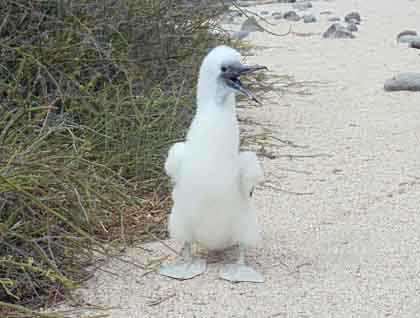Lying just beside Baltra, North Seymour is a low island with an uplifted sea floor.Although in the distance it looks small, flat and surrounded by cliffs, North Seymour offers a great number of endemic and native species with landscapes like nowhere else.
After spending the first night in the Galápagos aboard National Geographic Endeavour and after a comforting breakfast, we disembarked at North Seymour Island. We observed some playful sea lions swimming along the seashore and others resting on the black rocks. Meanwhile in the air, frigatebirds glided like kites taking advantage of the strong winds. The vegetation was composed of dwarf Palo Santo trees and deciduous vegetation. It looked dry and naked without the leaves typical during this part of the year.
Walking along the sandy trail we observed small marine iguanas. Their size and black color contrasted with the yellow land iguana which was two or three times larger. Just beside them, a group of female sea lions slept pleasurably while their noisy babies tried to wake them up to nurse. At the opposite side of the trail there were many blue-footed boobies nesting, feeding their chicks or incubating their eggs on the ground. Magnificent and great frigatebirds with their red pouches inflated, were the delightful to our guests.
After visiting North Seymour, we started sailing northwest to Rabida, a small island just south of Santiago. Its red sand beach was the result of oxidized iron and contrasted with the blue ocean and the green vegetation along the highlands. We began by kayaking along the seashore of Rabida where we observed sea turtles, fur sea lions, seashore birds, and blue-footed boobies in feeding frenzy.
After kayaking there was a soft mist, but it was not an impediment for our guests to discover the undersea world as they continued snorkeling from the Zodiacs. It was an opportunity to observe colorful fish, garden eels, sharks, green sea turtles, and the incredible Galápagos penguin. The last activity began with a landing on the red beach. Just behind it, a juvenile Galápagos hawk perched on the branches of a tree, observing us curiously for many minutes. Walking inland, we became acquainted with the spines of the prickly pear cactus as they are soft there, probably due to the lack of predators like land reptiles. We reached the highest part of the trail, where the landscape looked majestic with a sunset that illuminated our path with the last beams of the sun of this beautiful day.







